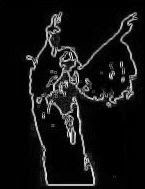I have used the phrase moral imagination in the college classroom for years. No, I am never certain students know what I mean. What I refer to is the way our story, especially in the Gospels and Paul's interpretation of Christ's paschal mystery, shapes the Christian to respond to moral conflict.
A moral dilemma might best be described as the conflict between two values. For example, the abortion dilemma concerns the clash between freedom of the host (pregnant woman) and the unborn's right to life.* The natural rights of life and freedom are at the top of most moral hierarchies.
To respond creatively to the dilemma -- that is, not simply a response determined by a rule book of moral do's-and-don'ts -- a person has to be shaped to see the possible. The apparent and the possible are not the same thing. The possible in the Christian story is modeled on (among other things) Jesus' self-emptying on behalf of others, the reversal of expectations in his Beatitudes, on the master washing his disciples' feet, the outcast choosing better than the elite, even the Hebrew midwives defying the embodied Egyptian god. Jesus's teaching -- love your enemies, do good to those who hate you -- his non-violent action, and the image of the slain lamb that conquers in the Apocalypse inspires one to not retaliate, to seek creative non-violent responses. This is the possible.
Both our vision -- that which we can see in-with-and-under the visual phenomena -- and our choices are shaped by our story. Yes, Christians use the Bible as a moral rule book, but I do not think this is the higher way. Perhaps the higher way is signaled in Jesus' parables, in which he defies the audience's expectations in favor of a creative response that more faithfully reflects the highest values. Jesus dis-orients us so that we can truly see the possible beyond the habitual.
Consider the example of Blessed Teresa of Calcutta: the possible was not simply whom to marry, family prosperity, etc. Rather, for her the possible was to empty herself on behalf of this world's wretched. She chose the option that our story opens to us. This creative choice is not simply doing her duty.
This is the Christian moral imagination: in the midst of moral conflict, the seeing and choosing of options only opened to us by our story. The Christian imagination is more than moral vision, but it is never less than a way of seeing, a worldview, that has been shaped by our story. Perhaps in another blog I will write more generally on the Christian imagination, which I call sacramental.
*It is not a clash, however, between the human rights of freedom and life because the pro- and anti- positions do not agree on what constitutes a human person. In other words, are the unborn "endowed by their Creator with certain unalienable rights, that among these are life, liberty"? If US citizens agreed on what constitutes a human life, there would likely be no moral dilemma because only the most extreme minority supports the killing of human beings. If the unborn are human beings, they have human rights. Abortion is not an option.
Wednesday, October 8, 2008
Subscribe to:
Post Comments (Atom)


No comments:
Post a Comment